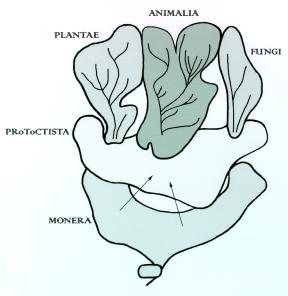What is Life on Earth Like Today?But what is life on Earth really like today - how well do we know the life on our own planet? The answer to this question is probably, “Very poorly,” especially if we consider the full complement of life on Earth. To do so, we must take into account not only the “higher” organisms, but also the single celled, anucleate organisms collectively referred to as prokaryotes. These organisms need to be factored into any discussion of the nature of life on Earth, both past and present. To illustrate the way in which prokaryotes are viewed now in comparison to just a few years ago, I offer the following quotation from Dr. E. 0. Wilson, the noted expert on animal evolution, from his book, The Naturalist. If I could do it all over again and relive my vision of the 21st century, I would be a microbial ecologist. Ten billion bacteria live in a gram of ordinary soil, a mere pinch held between the thumb and the forefinger. They represent thousands of species, almost none of which are known to science. Into that world I would go with the aid of modern microscopy and molecular analysis. Dr. Wilson has made immense contributions to our understanding of macroscopic life on Earth, and in this quote expresses the opinion that it is now time to move such thinking to the microbial level. To expand on these thoughts, I would point out that while microbial biomass is thought to account for 50% or more of the Earth’s biomass, we have been able to culture and characterize only a small percentage of these prokaryotes, and thus, know almost nothing about nearly half of our Earthly biota. This is a sad state of affairs for a society that claims to be ready to embark on a search for life in the Universe! In addition to our new insights about the early appearance of Earthly life, a number of other biological findings have changed our perceptions of life on Earth. These new developments, which must be factored into any search for extraterrestrial life, involve the nature and diversity of life on Earth (e.g., the very definition of Earthly life), as well as new insights into the toughness and tenacity of life as we know it. With regard to our view of the nature of life on Earth, major changes
have occurred in the past two decades.
We have moved from a peculiarly eukaryocentric view of life to one that
openly admits that the small, single-celled creatures that were once ignored
play a vitally important role in the metabolism of our planet.
Figure 3. The five kingdoms of life. This view represents Earthly life as composed of 5 kingdoms, 4 of which are eukaryotic, and the 5th, the monera (what we now call prokaryotes) at the base of the tree. This view of life is based on structural and functional analyses of organisms, and a proposed evolutionary line in which life moved from simple to more complex, and smaller to larger. This classification scheme relied upon observation of the visible features of organisms to give each a name (e.g. Homo sapiens for humans), and to group organisms of similar appearance together. The diagram in Figure 3 is called a phylogenetic tree; these trees are used to illustrate the evolutionary progression that may have occurred to result in the extant organisms (e.g., to answer the question of which organisms preceded which in time). Largely because of the nature of the tools available (human eye, hand lens, and later, simple microscopes), it is not surprising that the such trees were dominated by the macroscopic, many-celled eukaryotes such as the fungi, plants, and animals. The tiny eukaryotic protists (amoebae, paramecia, giardia, etc.) being visible but not understood, were relegated to the next-to-the-bottom rung of the ladder, while the prokaryotes (bacteria) were handily put at the bottom where they could be acknowledged but not seriously so. This entire approach was reasonable at the time, in the sense that structural diversity was driving classification, and the single celled, anucleate prokaryotes, as they are called, have little that is comparable with the structurally and behaviorally diverse larger organisms, collectively referred to as the eukaryotes.
Contributed by: Dr. Kenneth Nealson |






